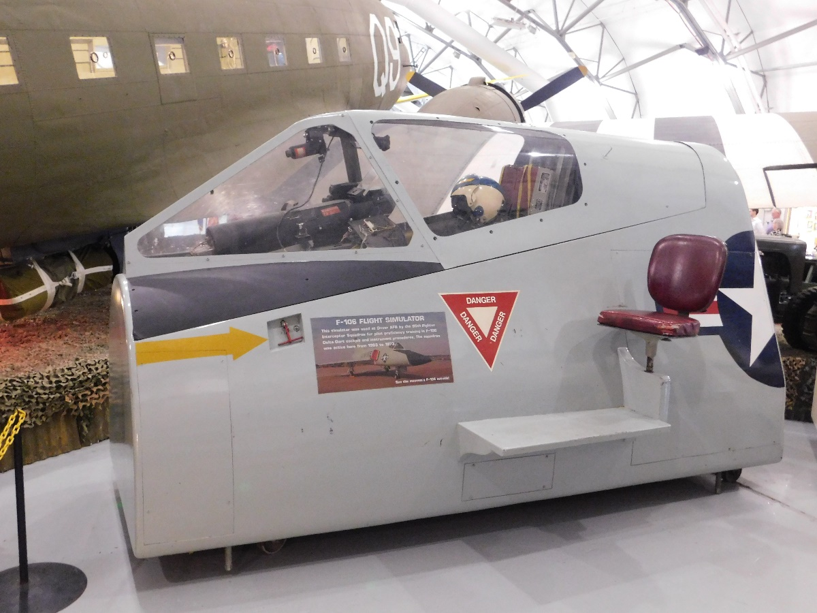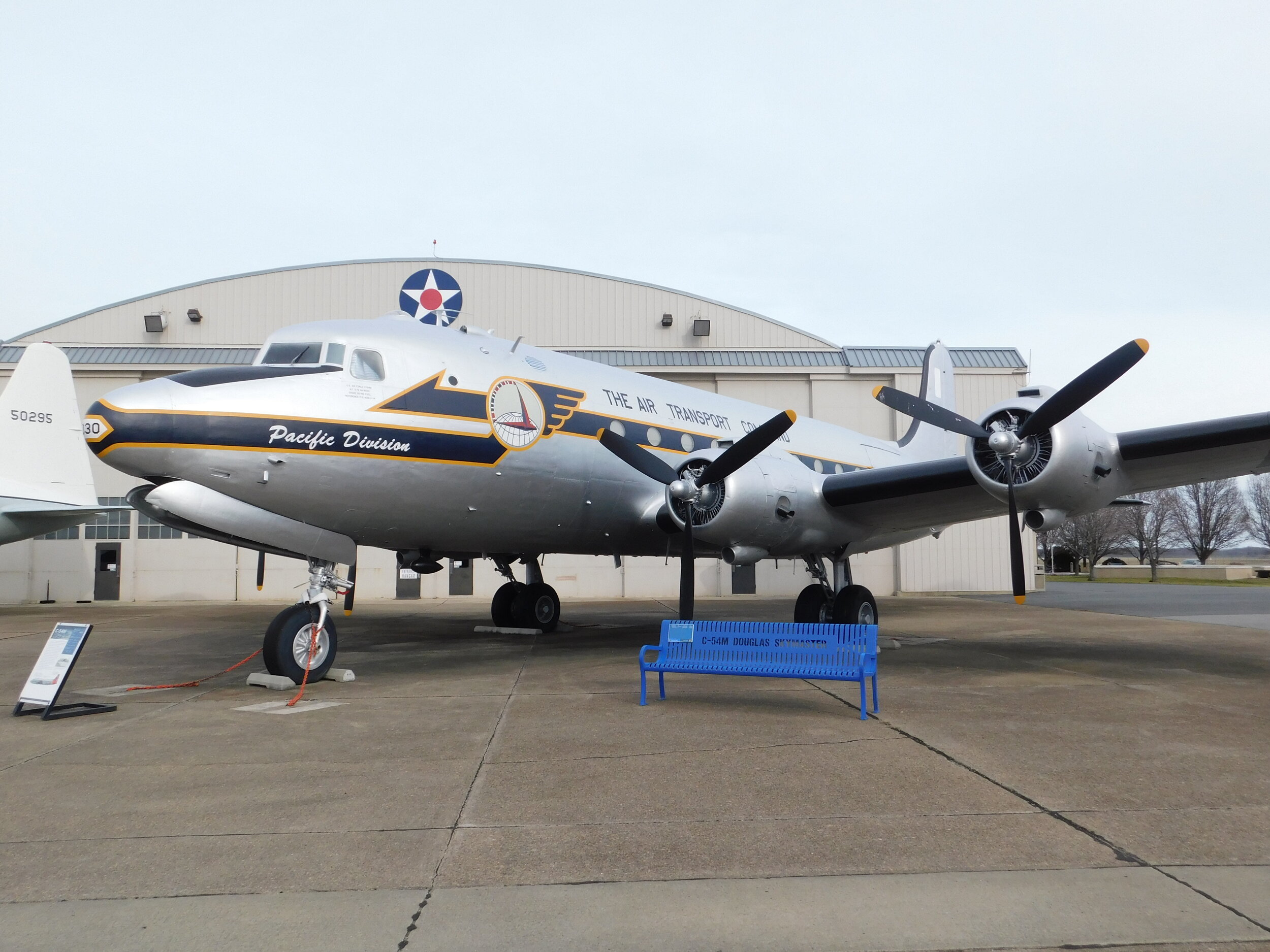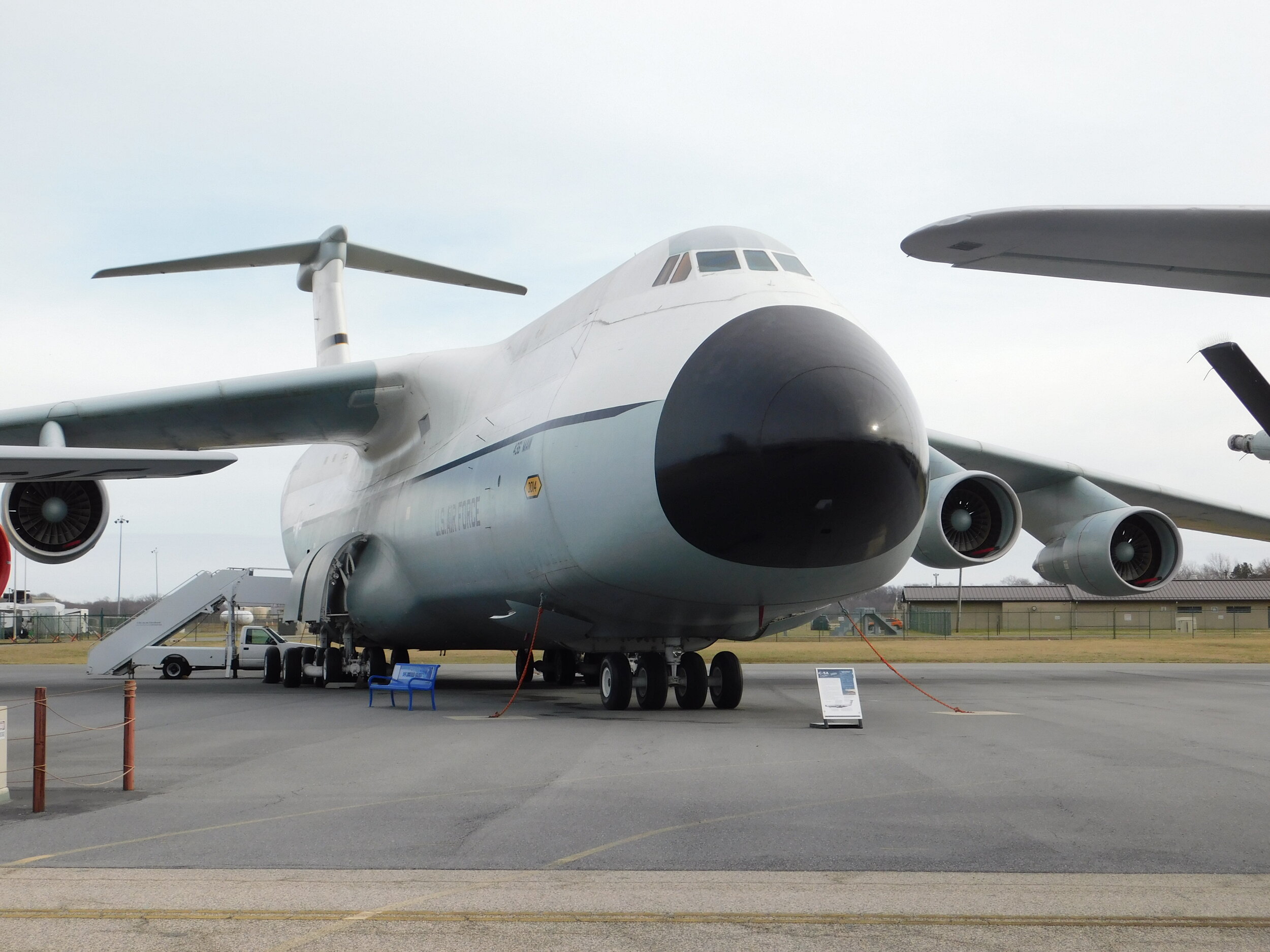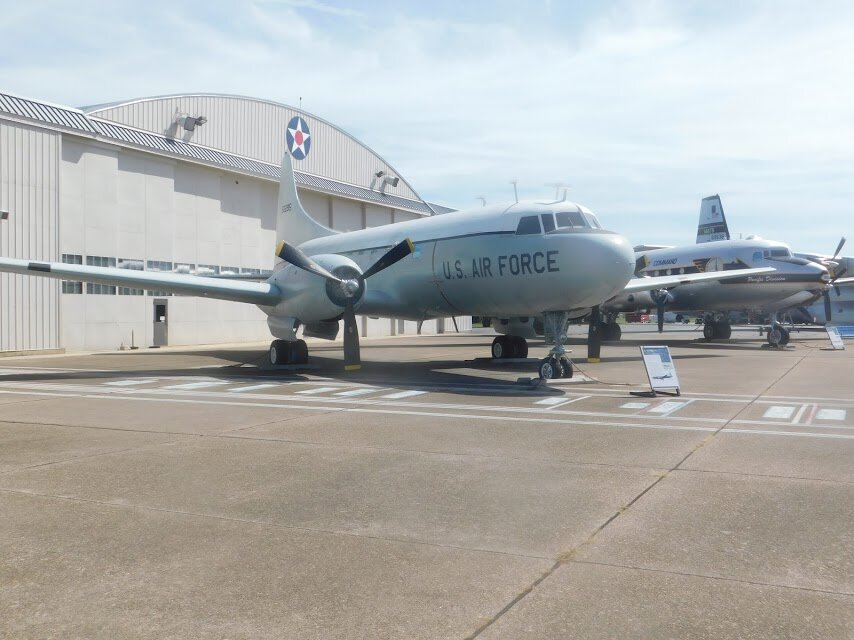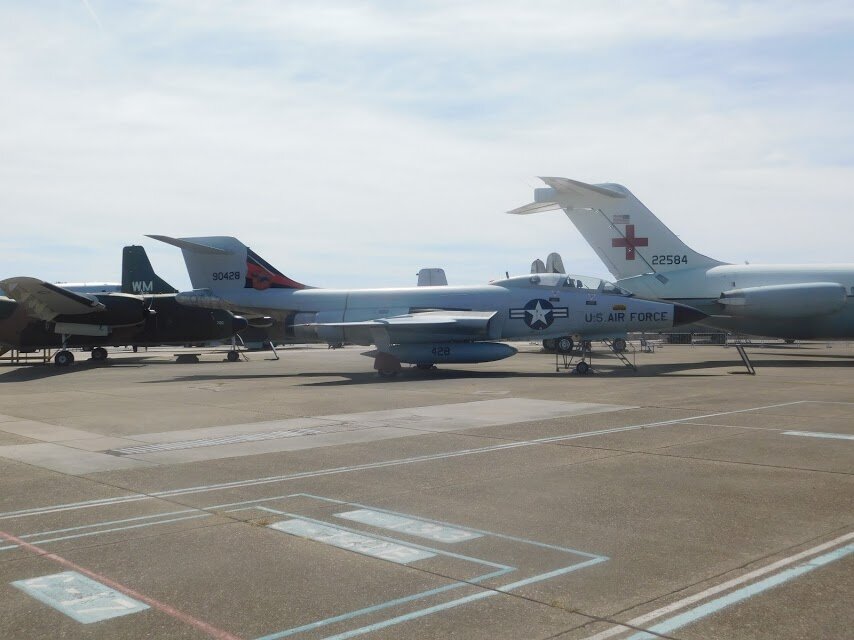Air Mobility Command Museum, Dover Delaware
On October 24th, 1974, a little-known event in the history of the Cold War took place over the Pacific Ocean. Testing a strategic theory of the time, a Lockheed C-5A Galaxy departed Hill Air Force Base in Utah loaded with an 86,000-pound Minuteman Missile. The huge C-5 headed out over the Pacific. When level at 20,000 feet, the crew opened the rear cargo door and released the drag chutes that were connected to the cradle holding the missile. When the chutes opened, the cradle was released and the 86,000-pound rocket rolled out the back of the C-5. As the Minuteman fell, the drag chutes aligned it vertically and, at 8,000 feet, the rocket engines were ignited for 10 seconds. The missile quickly soared above the C-5 and then dropped into the Pacific, completing the successful test.
Nuclear missiles were never deployed aboard cargo planes, but this successful test showed it was possible. It became just one more bargaining chip in the Strategic Arms Limitation Talks (SALT II) with the Soviet Union. The C-5 that dropped the Minuteman Missile that day, 90014, is now on display at the Air Mobility Command Museum at Dover Air Force Base in Delaware.
I’ve always liked large planes and the Air Mobility Command Museum certainly has many. Founded in 1986 the museum summary sheet states: “the museum houses a growing collection of vintage planes and artifacts that reflect the evolution and history of the Air Mobility Command and of the varied missions of Dover AFB since its beginnings in 1941”. The Air Mobility Command (AMC) was established in 1992 and its history includes its predecessors; The Air Transport Command (ATC), 1942-1948, The Military Air Transport Service (MATS), 1948-1966, and the Military Airlift Command (MAC), 1966-1992.
The museum has two distinct sections, an interior hangar and an outside ramp. Let’s start outside. To me, this is the most interesting part of the museum and I highly recommend visiting in good weather.
Photo Courtesy of AMC Museum
There are over 20 aircraft outside and, on most days, at least two of them are open for self-guided tours. Let’s start with a look at one of the best-known Air Force transports, the Lockheed C-141 Starlifter.
The Museum has two C-141s, an A and a B model. This A model (serial number 61-2775) was the first C-141 built. The Air Force had used a variety of prop and turbo-prop aircraft for transport in the 1950s but there was a clear need for more range and speed. The first jet transport available was the C-135 (Boeing 707) but it had limitations; mainly, it had no large cargo door. In the early 1960s, Lockheed produced the first jet transport designed from the ground up for cargo operations, the Starlifter. The prototype (this plane) first flew on December 17th, 1963, which was the 60th anniversary of the Wright Brothers’ first flight. This airframe is one of only four A models that were not converted to a C-141B and it spent its entire career as a test-bed aircraft. Its final mission, in 1997, was towing a QF-106 to altitude to assess if a space shuttle could be launched that way.
Photo courtesy of NASA
Beginning in 1977, most of the C-141s in the Air Force inventory were converted to B models. The conversion included lengthening the fuselage 23 feet and adding a re-fueling boom receptacle. These changes gave the 141 capabilities that allowed it to remain operational until 2006, a very productive service life of 40 years. One of the final missions of the C-141 (carried out by reservists) was providing relief flights after Hurricane Katrina.
The Museum has a number of aircraft that are “firsts” (such as the C-141A) and a number that are “lasts”. Starlifter 64-0626 fits this theme, as it was the last C-141 stationed at Dover AFB, being retired in February of 1996. Click to see a list of the museum’s firsts and lasts. https://amcmuseum.org/at-the-museum/first-last-and-only/
The Lockheed Constellation was originally built during WW-II as the C-69. After the war, the Air Force settled on the C-54 as its main transport and made the Constellations surplus- many of them winding up with the airlines. There were numerous variations and upgrades made to the Connie and during the 1950s, both the Air Force and the Navy purchased the C-121 Super Constellation. The C-121 served in many roles including Distant Early Warning, VIP transport (it was the first aircraft designated “Air Force One”) and even as a support aircraft for the Blue Angels. The Connie in the museum never served in the military but is painted to resemble a C-121C as was used by the Air Force for general air transport. This Connie flew with a number of airlines including: Cubana, BOAC and Eastern before being retired by Capitol Airways. (For an interesting picture of the final stop of this plane before being restored in Dover, continue down to this month’s Museums Are Where You Find Them).
Let’s take a look inside the hangar. During WW-II, various secret rocket development activities took place on Dover Army Airfield. The home to these activities was Hangar 1301. From the 1950s to the 1970s, various fighter squadrons called this hangar home. In the 1990s, after restoration and placement on the National Register of Historic Places, Hangar 1301 was given new life as the home of the Air Mobility Command Museum.
The hangar contains many interesting exhibits, most of which center around air transport. Three aircraft are the center points of interest, A C-47, a B-17 and a CG-4A glider.
CG-4A glider cockpit Photo Courtesy of AMC Museum
There were several gliders designed during WW-II, but the Waco CG-4A became the standard, with almost 14,000 built. Gliders never got the exposure other aircraft did, and have not been written about much, but they played a very important role in the war. With no motor, these aircraft have obvious limitations, but they have advantages too. They were cheap to build and were very quiet when approaching a landing zone! The glider displayed in the museum was manufactured late in the war and never saw combat. It was restored using original blueprints and one side of the fuselage was left uncovered to display the intricate structure and the payload. Half of one wing was left off, also showing the structure. The display goes well with the nearby C-47, the main tow aircraft for these gliders.
The C-47, of course, is widely known and admired. Like the C-47 in the National WW-II Museum (see issue 7), this C-47 participated on D-day, during Operation Market Garden and in the Berlin airlift. This particular aircraft had been deemed unrestorable by other museums (among other things, it had been used for target practice), but, in 1986, it was taken on by a group of restorers in Dover and became the first plane in the museum. The life of this C-47 is extremely well documented around the display and on the website, and a number of personal stories of the crew are included. On the website, there is even a first-person account of its mission on D-day.
The C-47 is displayed as it might have been, preparing for a mission to support operation Market Garden. The story of D-day, has been well told, but it was just the beginning of the campaign to conquer Germany. The Normandy invasion was a success, but there were failures to come, most notably Operation Market Garden in the Netherlands. The thousands of paratroopers who were dropped had mixed success and the Battle of Arnhem (a Bridge Too Far) was a brutal defeat. Of over 10,000 British paratroopers dropped, for instance, less than 3,000 escaped.
Photo Courtesy of AMC Museum
Dominating the hangar is B-17G serial number 44-83624 Sleepy Time Gal. Produced late in the war, this plane never saw combat, but it did serve the Air Force in a variety of roles until 1957. It makes the museum’s “first” and “last” list by being the last B-17 to drop live bombs. Assigned to a test squadron at Eglin AFB in Florida in the 1950s, this B-17 participated in public demonstrations of air power, comparing WW-II era bombers with more modern bombers. Also, at this test squadron, 624 was used in remote control bombing tests- an early development of drone warfare. Over 12,000 B-17s were produced and only about 40 remain. It is always a privilege to see one of these iconic airplanes beautifully restored and proudly displayed.
There are many other displays in the hangar, including re-creations of base-ops in the Korean War and the Vietnam War, each telling the story of logistical transport.
The museum also has several simulators on display, from an original “Link” Trainer to a C-141 sim. There was an F-106 fighter squadron stationed in Dover from 1963 to 1971 and there is an F-106 on display outside and an F-106 simulator in the hangar. Two of the simulators- a general education sim and the C-141 sim are available for visitors to fly.
C-141 Simulator
F-106 Simulator
Reader Gaylan Crumley sent memories of his personal experiences with the F-106 simulator and the F-106 on display outside. Scroll down below the Photo Gallery to read about his experiences. Thanks Gaylan!
Hangar 1301 is very large and there are many displays and artifacts to explore. Next to the hangar is the control tower that was in use at Dover from 1956 to 2009. Climbing the tower, you can hear live audio from the new tower, see planes taking off and landing as well as getting a great view of the collection of planes on the ramp.
One of my favorite planes out on the ramp is a C-54 Skymaster (Civilian DC-4). The C-54 was a workhorse transport during WW-II and beyond. The example in the museum is painted in the colors of the Air Transport Command (ATC) as it served in the Pacific during WW-II. A number of vintage photos of this plane show that the Skymaster still had this paint job during the Berlin Airlift. Like many C-54s, this D model was converted for carrying coal during the Airlift.
The C-54 had four Pratt and Whitney R-2000 engines. With a range of 4,000 miles, it could carry up to 49 passengers or 16 stretchers. A later model C-54 was given more range, R-2800 engines and square windows. This successful conversion went into production as the C-118/DC-6. Like the C-121, many C-54s were sold to the airlines after WW-II.
The Douglas C-9A Nightingale, a version of the civilian DC-9, was ordered by the Air Force in 1966 to perform medevac duties. The museum has two C-9s. This aircraft, serial number 67-22584, is another of the museum’s “firsts” as it was the first C-9 delivered to the Military Airlift Command (in 1968). The Navy later ordered the C-9B (after a spat with the Air Force over who could fly logistical missions), which were used for general personnel transport. This plane retired from the Air Mobility Command in August 2005 after 37 years of service. When delivered to the museum from Scott AFB, Illinois, the crew left the cockpit as it was when they landed. The approach charts the crew used that day remain in place in the cockpit, clipped to the yoke.
Photo Courtesy of AMC Museum
The second C-9 is a VC-9C. This plane spent much of its life at Andrews AFB in Washington, mainly serving as Air Force Two, for the vice-president. It occasionally served as Air Force One, if the president was travelling to a smaller airport. In its VIP role, this plane carried many world leaders including Queen Elizabeth II.
Photo Courtesy of AMC Museum
The VC-9 VIP interior has been retained and if you visit on a summer Saturday, you may find it open for visitors. If not, the website has photos and a virtual tour.
A little about the Museum’s website- it’s one of the best I have seen. It is very easy to navigate and contains a wealth of information. Each aircraft has its own listing where you can read a little about the model in general as well as about the specific airframe. Each plane has a photo gallery, many of which have a photo of the aircraft arriving at the museum (whether under its own power or in the cargo hold of a C-5). They all have a cockpit photo and some of these photos are interactive (all the cockpits have been kept in, or restored to, original condition). Rather unique on this website is that each aircraft has a complete listing (both military and civilian) of where it was assigned and who owned it throughout its history. The entire website makes very interesting reading. https://amcmuseum.org/
As you wander the museum ramp, you are likely to see some restoration work going on. During my visit, a Boeing KB-50 was receiving major attention.
The B-50 was an upgraded version of the B-29 bomber. Starting in 1956, some B-50s were converted to airborne tankers and designated KB-50 and the aircraft in the museum was the first B-50 to be converted. In order to be able to refuel jet aircraft, two jets were added to some aircraft and they became the KB-50J. Eventually, the KC-97 tanker was built, which itself was developed from the B-29. The KB-50 and the KC-97 both continued tanker duties until being replaced by the KC-135.
Across the parking lot from the main museum is a Quonset hut called “The Engine Barn”. It contains about 30 engines and most are well-described with some displayed to show the inner workings. Don’t miss this stop on your visit.
Pratt and Whitney R-4360 “Wasp Major” – with 28 cylinders, this is the largest production radial ever built.
Allison T-56 Turboprop as used on the C-130, P-3 and others
Unfortunately, there is not enough room to write about all of the planes in the collection, but let’s finish with another well-known transport, the Fairchild C-119. Known as the Flying Boxcar, over 1,100 C-119s were built and they served in military units throughout the world. First flown in 1947, the C-119 served in the Korean War and into the 1960s. This C-119 spent its military career in the Royal Canadian Air Force (RCAF). It deployed to Naples Italy in 1957 to support UN forces during the Suez Canal crisis. It was retired from the RCAF in 1965 and went on to civilian duty after that, including appearing in the movie Always. In 1969 it was converted to a fire bomber by Hawkins and Powers in Greybull, Wyoming (see issue 3 https://aviationhistorymuseums.com/blog/2019/7/18/museum-of-flight-and-aerial-fire-fighting-greybull-wyoming). The C-119 in the museum is a G model with Wright 3350 engines. The interior, which may be open for tours, has been converted back to a typical Air Force transport layout.
The Air Mobility Command Museum is great to visit, whether for a quick couple of hours or for an all-day affair. There is a large full-time staff and many volunteers who provide tours and obviously pride themselves in restoring and maintaining these historic aircraft. A gem of a museum.
To learn about what to do in the local area, museum hours and costs as well as books to read and other interesting odds and ends, keep reading! At the end you will find a photo gallery of the entire museum.
PLANNING YOUR VISIT
The Museum is open Tuesday - Sunday, 9 a.m. to 4 p.m. Closed all federal holidays except Veterans Day. Entry is free. The C-141B Starlifter and C-130 Hercules are open every day for self-guided tours if weather permits. The C-141B is also wheelchair accessible. On every third Saturday of the month, between April and October, the museum opens up some of its more impressive planes for guided tours. These aircraft will be opened to the public from 10 a.m. to 3 p.m. if weather permits and tour guides are available.
FLYING IN
Delaware Airpark (33N) is just 15 minutes away. It has a 4,200’ paved runway with VOR and GPS approaches. Self-fueling and rental cars are available.
LOCAL ATTRACTIONS
Dover International Raceway is nearby. The “Monster Mile” has two NASCAR races each year as well as other events. Lewes, DE is 35 miles away and is a pleasant seaside town. A great day out might be to visit the Air Mobility Command Museum in the morning and take the Cape May-Lewes ferry across the Delaware Bay to New Jersey. This scenic 90-minute trip takes you to Cape May, a great Victorian seaside town. It is then just a few minutes to the NAS Wildwood Museum -the subject of issue 5- https://aviationhistorymuseums.com/blog/2019/9/16/nas-wildwood-aviation-museum-cape-may-nj
WHERE TO EAT
There is a wide variety of restaurants just north of Dover AFB on S. Bay Road.
SUGGESTED READING
The museum website is excellent- containing a wealth of information. One area that is especially interesting is under the tab “history” Here you will find several hundred titles- vignettes about all sorts of subjects. Most of the entries are related to the airbase and its history, its operations and its people. Subjects range from Airlift During WWII, to the history of Dover AFB Officer’s Club, to information about the rocket experiments that took place in hangar 1301, now home to the museum. One title- On the Lighter Side tells about an array of locally grown sweet peas transported on a C-124 to Dover England for the annual Sweet Pea Society of England Show. All of the entries have a comments section at the end and many have comments from the people, or their relatives, who participated in the particular story. Each section is fairly short and they all make fascinating reading. https://amcmuseum.org/history.
Perhaps the definitive book on events surrounding Operation Market Garden is The Battle of Arnhem: The Deadliest Airborne Operation of World War II by Antony Beevor. This deeply researched book is full of details but is still very readable. Just a caution, some details are extremely graphic.
MUSEUM WEBSITE
https://amcmuseum.org/ An Excellent website!
UP NEXT
Harold F. Pitcairn Wings of Freedom Aviation Museum, Willow Grove, PA.
MUSEUMS ARE WHERE YOU FIND THEM
This segment is dedicated to finding interesting aviation artifacts that are in public view- but not in an aviation museum. If you see one send a photo!
Photo Courtesy of AMC Museum
The C-121 Super Constellation in the museum was once a cocktail lounge above a restaurant in Langhorne Pa. Originally called Jim Flannery’s Lounge and Restaurant (Flannery was a B-29 pilot in WW-II), the restaurant was later named Amelia’s and then The Airplane Family Restaurant & Diner.
Photo Courtesy of Robyn Druce
Reader Robyn Druce sent this photo of a DC-3 being used as a kid’s party room at a McDonalds in Taupo, New Zealand. Robyn works for the HARS Aviation Museum in Australia. The museum has a number of historic aircraft that are in flying condition and is in the process of receiving a 707 donated by John Travolta. Thanks Robyn!
PHOTO GALLERY
Air Mobility Command Museum
click any photo to enlarge
Issue 9, Copyright 2020, all rights reserved.
Unless otherwise noted, all photos by the author
From reader Gaylan Crumley:
“In 1971, my first assignment upon graduating from USAF Pilot Training was the F106 Delta Dart at the 95FIS at Dover AFB, DE. Upon arriving at the 95th in March of 1972, I learned that the squadron had just been selected to be deactivated in March of 1973. So after the squadron deactivated in 1973, the F106s were sent to the Air National Guard at the 119FIS in Atlantic City, NJ.
In 1979, I separated from active duty and was hired by the 119FIS where the F106s from Dover were still flying. I was only there a short time since I moved to Houston, TX and was hired by the 147th FIG at Ellington Field flying the F101 and the F4. In 1985 I rejoined the 119FIS and yes, the unit was still flying the F106s that had been stationed at Dover AFB.
In 1988 we were the last squadron to still be flying the F106. So we traded in the Delta Dart for the F16. For a short period of time we had both aircraft in the air as we were going through the transition phase. It was a beautiful sight seeing the F106 and the F16 flying side by side.
Each squadron had a simulator for periodic training and it just so happened that I was the last pilot to fly the F106 simulator. I thought nothing of it at the time, but in 1985 Dover AFB had started a military aircraft air museum. The Smithsonian turned down our offer of the simulator, but the air museum at Dover gladly took it. So in 1988 the simulator was shipped over to Dover AFB.
After the F106s left Dover they eventually found a home at Tyndall AFB as drones. It was great to see the F106 still flying although now they were being shot at.
In 1988 I was the Operations Group Commander at the 119FS and received a call from our pilots who were TDY at Tyndall. They said that the F106s were being dumped in the Gulf of Mexico as manmade reefs. One of the Dover/Atlantic City F106s had not yet been dumped and wondered if we would like to have it back. We didn’t have room for it at our unit, but I thought of the Dover AFB Museum and made a call and asked the Museum if they would like to have it. They were delighted to have it come home to roost. So one of the Tyndall drone pilots flew it back and after a couple of low passes at Atlantic City he then flew it to Dover for its final gear down full stop landing.
We had some of our maintenance technicians who had worked on the F106 and who drive to Dover to repaint the aircraft. So when one visits the Dover AFB Museum and sees the F106 they can know that this Delta Dart is truly home again. Also, inside the hangar is the F106 simulator. Someone was nice enough to stencil on the inside of the back panel door, “Last flown by Gaylan Crumley” along with the name of the crew chief technician, Gene Takoty who was responsible for keeping the simulator up and running”.
Thanks Gaylan!















